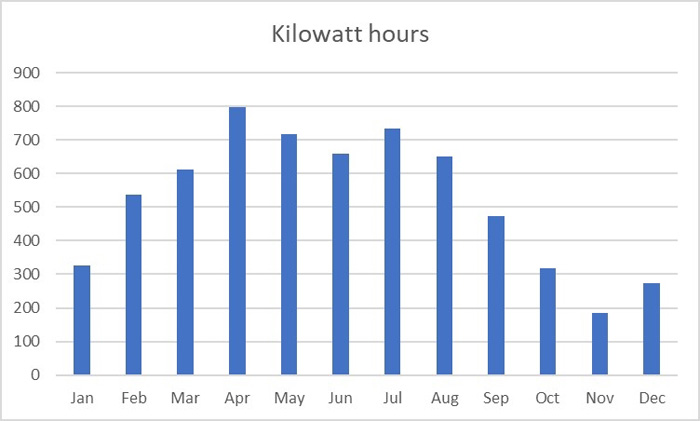Rethinking Lifestyle
One year of Solar Panel Experience

One year ago, when my solar panels came on line, I expected to produce about 7 Megawatts of power annually based on advertised averages and assumptions. My experience fell slightly short of that by producing 6.3 Megawatts, about 90% of my expectation.
There are 14 solar panels on the 45 degree south facing roof of my little house. Each panel is rated at 325 watts giving the entire system a rating of 4.55 kilowatts. The system is grid tied which means that I am also hooked up to the regular hydro power lines. When the solar panels produce power, they first supply the house directly and if there is anything left over that I am not using, that excess power is sold to Manitoba Hydro. When my little house uses more than the solar panels can produce, I draw hydro power from the lines. The meter on my pole has two readings: power consumption and power production. This power production is the excess production not the total production of the system. The total production is measured by a small meter attached to the solar system.
I was certainly more aware of sunny and cloudy days knowing that I can produce just over 30 kilowatt-hours on a sunny day compared to just 9 kilowatt-hours on an average cloudy day. It turns out that April was the most productive month, producing 799 kilowatt-hours with only two cloudy days in the whole month. On the other end of the extreme, October and November were the cloudiest with only one completely sunny day in all of November. The worst production day was November 15 with only 1.2 kilowatt hours produced for the entire day.
For a two year period ending in April 2018 Manitoba Hydro offered a capital rebate on solar installations and a contract to pay $0.08/kilowatt-hour for the excess power, which is the same as what I pay when I buy electricity from Hydro. I signed up and installed the system during that period of time. I understand that a new contract today would pay approximately $0.03/kilowatt-hour.
Manitoba Hydro gave me a rebate of $1000/kilowatt. The total cost of the solar panels including the converters and installation was $13,500. My net cost after subtracting the $4500 rebate was $9,000. The system size (4.55 kilowatts) was calculated by Manitoba Hydro to approximately make my Hydro bill zero for the year. My hydro bill was negative (a credit) for the months of May through September. My total net cost of hydro power for the year was $383 so it was not quite zero. So what was my saving? My total hydro bill the previous year was $1277. Using those figures, my saving was $1277-$383= $894. However this is not a perfect comparison because the winters of 2017 and 2018 were not the same. Calculating another way, the 6,300 kilowatt-hours that my solar panel meter says I produced are worth $0.08 per kWh. Then my saving was 6300x$0.08 = $504.
If I use the lower number, $504, as a return on the $9,000 investment, then the return on investment was 5.6%. I am happy with the way the solar system operated. It is very easy to maintain. I only had to remove snow three times during 2018. The system has a 25-year warranty.
An individual who would sign and install now, would not achieve the same savings. He would get only $0.03 per kWh for surplus electricity. This means that whenever the panels are displacing purchased electricity, the value of that electricity is $0.08 per kWh. However if the panels are producing surplus, that surplus is worth only $0.03 per kWh.




